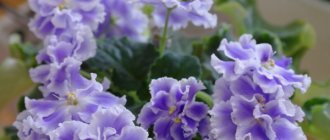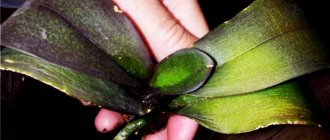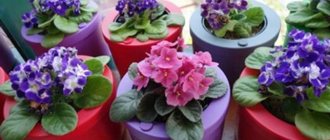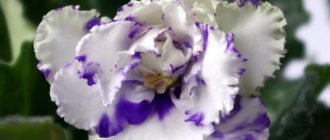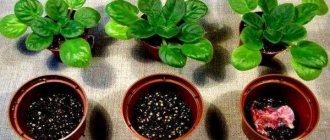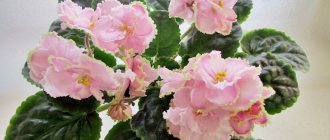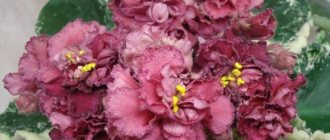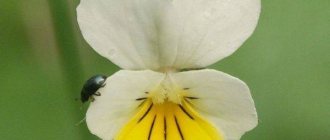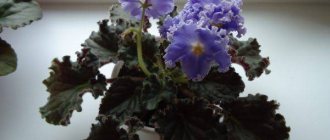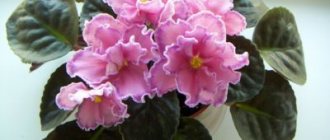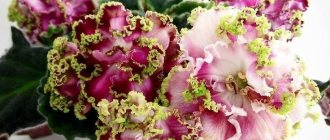Violets are common ornamental plants that are grown mainly indoors.
A wide selection of shades and varieties of this crop allows you to create a mini-flower bed at home. Dear readers!
For you, we have created communities on social networks in which useful articles and interesting ideas are published several times a day! Subscribe and receive useful content in a convenient format! A very popular type of violet is “Blue Fog”. The variety is distinguished by double, simple and fringed flowers.
Description of the variety
This variety of violet cannot be called capricious. But follow simple, basic conditions that will prevent the development of diseases and accelerate the development of the flower.
Story
"Blue Mist" was first released in 2001.
This type of indoor violets was developed by Konstantin Morev.
Its homeland should be considered one of the provinces of East Africa.
The name of the Saintpaulia flower corresponded to the name of the governor of the province.
Interesting! Morev gave his creation the following description: “Large terry soft blue stars with a slightly wavy white border.”
Leaves
The leaves of the violet are velvet-type, as in the photo on the left. The shape can be ovoid, oval, round or with a heart-shaped base.
Depending on the species, the outer part of the leaf takes on different shades: from light to dark green.
The inner surface is light green or lilac.
The veins are clearly visible on it.
Flowers
“Blue Fog” is characterized by inflorescences of a heavenly hue and quite large in size, as in the photo below. The shape is spherical, there is a wavy finish along the edge of the flower. It has a shade that is one tone lighter than the main one.
Violet violet: names of varieties and description
Violet Violet: photo
- “LE - Lilac Rain” is a plant with large fuzzy buds of a creamy pastel purple color, shimmering with a dark purple color. The size of the inflorescences can reach from forty-five to fifty-five millimeters. The leaves are large, dark green with a yellow wavy edge. The rosettes are neat, located close to each other. This species is not squeamish in care.
- “Lilac Delight” is a charming plant with large, fuzzy buds of a light lilac color with the addition of neat purple stripes. The highlight is that there are three purple spots in the middle of the bud. The leaves are oval and wavy. Decorative species, long-term flowering.
- “N - Lilac Smiley” is a very beautiful plant, with large fleecy buds of lilac color with a snow-white outline. The leaves are oval, emerald green, brown on the underside. The inflorescence is located closer to the center.
- “RS – Lilac Miracle” is a charming type of violet, large buds with pastel purple hairs with a white edge. The size of the buds develops up to seven centimeters. The leaves are ordinary, oval, green in color. The size of the rosette reaches up to twenty-five centimeters. The plant is easy to care for, not squeamish.
- "Lilac Excitement" is a charming plant with large, fuzzy buds. The petals are of two colors, either dark purple or pastel purple. The leaves are dark green in color. The underside of the leaves is brown. The highlight of the plant is its wide, regular and long inflorescence.
- “PT-Lilac distance” is a beautiful flower with large fuzzy buds of pastel lilac color, the center is purple. A compact rosette of dark green leaves with yellow lining around the edges.
- “Lilac Sand” is a plant with a surprisingly bright shade of buds. The highlight of the flower is the usual creamy pinkish large inflorescences, on which there are splashes in the form of a purple pattern, the leaves are light or dark green.
- “Lilac mist” - Saintpaulia, a neat rosette of a plant, consists of a cluster of dark green leaves with ribbed edges. When the plant blooms, all the buds accumulate in the center. The color of the plant can range from light lilac to purple. Petals with villi, curl. The plant is fastidious in care, so it needs to be carefully looked after; if this is not done, the plant simply stops blooming.
- “Lilac watercolor” is a charming plant with large buds of a light lilac color with a snow-white pattern along the edges and in the middle of the flowers. The leaves are emerald in color, such a contrast in the plant looks very impressive.
- “AB – Purple Elephant” is a recently known plant species; its inflorescence collects a large number of flowers. The flowers are large in size with lilac-colored fibers with a snow-white edging along the edges.
- “Lilac charm” is a plant of unusual beauty; gardeners love this plant very much for its beauty and attractiveness. The buds have fibers and are sometimes smooth. The color of the buds is in the form of a pattern of multi-colored splashes of pinkish, lilac shades on a cream color. The outline is purple.
- “KO – Lilac Paradise” is a charming plant, its rosette is neat. When the plant blooms, a creamy lilac cap forms in the middle. The petals are white. The edging is also light. The leaves are oval-shaped, wavy, elongated, green.
Planting and propagation
This type of plant is best propagated by leaf cuttings. For these purposes, it is necessary to select a strong and healthy leaf from the second lower tier.
To root the resulting cuttings, it is worth using water. The container should be dark, pour water into it, and place activated carbon tablets.
Place the sheet in a container so that only the tip is placed in the liquid. After 2 weeks, roots will form. Now is the time to plant the plant in the ground. If all agrotechnical rules are followed, babies will form on the cuttings within a month.
Leaf cuttings can be rooted directly in the soil. For these purposes, after cutting the plant, plant it in a loose and nutritious substrate.
To make the cutting stable and not fall, you need to secure it using toothpicks.
Cover the top of the sheet with polyethylene. As soon as the babies have formed, the cuttings can be planted in separate pots. Read more about violet propagation
Purple violets: review of varieties with descriptions
Each person tries to surround himself with objects of a certain color. This color changes depending on age. Florists are people too, and in their collections they prefer the colors and shades that best suit their mood at the moment. Fortunately, even in text mode it is possible to convey the emotional component of a shade, for example, the purity of a snow-white color scheme. We will try to convey the beauty and nobility of lilac violets.
- Lilac Charm. The variety has impressive (relatively) lilac flowers with three dark lilac markings in the middle of the flower. The fringe is a thread of the same dark color, only along the edge of the petals;
- Beloved Daughter. Large, simple plants of a soft lilac lavender hue, with a thick dark purple fringe on the edge of the petals;
- Lilac tenderness LE - classic Uzambara violets with large soft white-lilac or white-pink double flowers, shaped like large stars. Has a standard light socket;
- Unobtrusive Sadness LE. A soft blue plant with slightly darker petal tips. The piquancy of the flower is given by the green ruffle along the edge of the petal. This violet has dark, slightly wavy leaves that shine;
- Currant dessert-EK. Voluminous fluffy and half-double stars with pronounced fringe of an extremely beautiful shade, reminiscent of blackcurrant jam. The foliage is green and velvety.
- EK-Mikhail Lermontov. Just giant lilac Saintpaulias, decorated with fringe. The peduncles are strong, pronounced, the rosette is dark, has an exhibition appearance;
- EK-Turquoise Jellyfish. An interesting fact is that Saintpaulias of this species are truly impressive in size (about 7 cm in diameter). They have a “marine” shade of petals and sky-blue fringed edges. The rosette of these violets is green and compact, consisting of pointed leaves.
- Ward Brown - Impressive violets in terms of size with huge fluffy inflorescences. These Saintpaulias have a rich amethyst (inky color), star shape with slightly curved lilac-bluish edges;
- Velvet Frost are very large, half-double stars with white trim. Saintpaulias of this type are distinguished by lush flowering, a neat base of the petals and green leaves with a ruby-red underside;
- Rodeo Roper is a relatively large Saintpaulia with a velvety purple color. The flowers are edged with a contrasting, slightly embossed white border;
- Rodeo Glory - impressive velvet violets with dark purple double flowers that shimmer with black. Saintpaulias of this type have the edges of the petals in the form of an accordion;
- Rebels Centennial Mtar (R. Bunn) – Extremely voluminous dark ruby half-double stars with dark green leaves;
- Optimara Van Gogh (Holtkamp) Huge size violets the color of a concentrated solution of manganese in the shape of a star with green foliage;
- Optimara Hisako is a rather large dark purple or dark cherry pansy with a distinct white center. Very impressive;
- Maria Silvia. Common pansy with a light lilac flower. The ends of the petals of this Saintpaulia are dark lilac, and the foliage is green;
- Lions Pyum-Pudding is a rather original semi-double two-color Saintpaulia of dark plum and red shades. Frilly star.
- Louisiana Lulubai - by normal standards, these are simply huge violets (8-9 cm in diameter). These Saintpaulias come in double, semi-double stars in a soft lavender hue with dark purple flower tips;
- Fisher Lyon. Plum-purple violets with pink stripes, dashes and strokes in the power of fantasy;
- Dixie Doris - Quite large double violets of various shades of lavender with dark endings at the tips of the petals and a greenish-white wavy border;
- Carmival (F. Tinari) - relatively large Saintpaulias of soft purple shades with a green flower base and the same leaves;
- Apache Shadows are dark red-purple plants with wavy flowers. These flowers feature variegated green foliage with pink and white splashes.
- Apache Midnight and Rodeo Glory. Large dark plum flowers with double velvety petals. The inflorescences have black petals with accordion-shaped edges and a thin white edge. Pronounced green foliage;
- Apache Magic - relatively large, semi-double inflorescences of a dark purple hue. They are distinguished by strongly wavy white-green edges. White and pink variegated;
- EK-Baltica. Extremely large semi-double light purple flowers with a wide white border on the petals;
- Rebels and Centenual Star are impressive simple dark semi-double blood violets shaped like stars. They have dark green pointed leaves. They are distinguished by rich and bright flowering;
- Fischer Lyon. A simple dark semi-double flower in a plum pink fantasy style;
- Child's favorite. White half-terry lace Saintpaulia with blue eye, rays and border. The base of the petals is green, flat and somewhat quilted;
- Buckley Blushing is a semi-double or double lavender lace pansy in a purple fantasy style.
Energy of color
Many florists are attracted to lilac plants, the color obtained by merging two colors - red and blue.
The color lilac is considered a living color, but psychological experts believe that its shades cause a feeling of anxiety.
People who have a negative attitude towards lilac shades are extremely lucky in the field of business, because this color is preferred by individuals who avoid a specific answer and do not know how to maintain an open dialogue. The favorite pastime of individuals who prefer lilac tones to others is nostalgia for the past, and this is a direct road to nowhere. Each color is capable of a certain energy and it would be a sin not to use it.
Video “Caring for Violets”
In the video, a woman shares her experience of caring for indoor Saintpaulias. After watching the video, you will learn how often you need to water this plant, what to fertilize it with, and what kind of soil you should plant it in.
myorchidea.ru
Care
Despite the fact that the violet variety in question is unpretentious in care, you still need to follow some recommendations.
Watering
This process is very important for violets, since it is high-quality watering that contributes to the rapid development of violets.
For irrigation, use settled water , and its temperature should be slightly above room temperature.
For watering, use a watering can with a thin stand. In this way, moisture can be prevented from penetrating the flower.
Moisturize 2 times a week. The main thing here is not to overdo it, as excess moisture will lead to rotting of the roots. This can be determined by the presence of brown spots on the leaves.
Transfer
It is worth replanting the blue flower in the fall. Then the plant will be able to adapt to winter frosts. During transplantation, you need to be careful not to damage the rhizome.
Fertilizer and feeding
For the Blue Fog variety, it is necessary to use liquid organic matter and tablets. Apply fertilizing to the soil during the flowering phase, and a second time as needed.
Review of purple and lilac varieties of violets
Each person tries to surround himself with objects of a certain color. This color changes depending on age. Florists are people too, and in their collections they prefer the colors and shades that best suit their mood at the moment. Fortunately, even in text mode it is possible to convey the emotional component of a shade, for example, the purity of a snow-white color scheme.
- Lilac Charm. The variety has impressive (relatively) lilac flowers with three dark lilac markings in the middle of the flower. The fringe is a thread of the same dark color, only along the edge of the petals;
- Beloved Daughter. Large, simple plants of a soft lilac lavender hue, with a thick dark purple fringe on the edge of the petals;
- Lilac tenderness LE - classic Uzambara violets with large soft white-lilac or white-pink double flowers, shaped like large stars. Has a standard light socket;
- Unobtrusive Sadness LE. A soft blue plant with slightly darker petal tips. The piquancy of the flower is given by the green ruffle along the edge of the petal. This violet has dark, slightly wavy leaves that shine;
- Currant dessert-EK. Voluminous fluffy and half-double stars with pronounced fringe of an extremely beautiful shade, reminiscent of blackcurrant jam. The foliage is green and velvety.
- EK-Mikhail Lermontov. Just giant lilac Saintpaulias, decorated with fringe. The peduncles are strong, pronounced, the rosette is dark, has an exhibition appearance;
- EK-Turquoise Jellyfish. An interesting fact is that Saintpaulias of this species are truly impressive in size (about 7 cm in diameter). They have a “marine” shade of petals and sky-blue fringed edges. The rosette of these violets is green and compact, consisting of pointed leaves.
- Ward Brown - Impressive violets in terms of size with huge fluffy inflorescences. These Saintpaulias have a rich amethyst (inky color), star shape with slightly curved lilac-bluish edges;
- Velvet Frost are very large, half-double stars with white trim. Saintpaulias of this type are distinguished by lush flowering, a neat base of the petals and green leaves with a ruby-red underside
- Rodeo Roper is a relatively large Saintpaulia with a velvety purple color. The flowers are edged with a contrasting, slightly embossed white border;
- Rodeo Glory - impressive velvet violets with dark purple double flowers that shimmer with black. Saintpaulias of this type have the edges of the petals in the form of an accordion;
- Rebels Centennial Mtar (R. Bunn) – Extremely voluminous dark ruby half-double stars with dark green leaves;
- Optimara Van Gogh (Holtkamp) Huge size violets the color of a concentrated solution of manganese in the shape of a star with green foliage;
- Optimara Hisako is a rather large dark purple or dark cherry pansy with a distinct white center. Very impressive;
- Maria Silvia. Common pansy with a light lilac flower. The ends of the petals of this Saintpaulia are dark lilac, and the foliage is green;
- Lions Pyum-Pudding is a rather original semi-double two-color Saintpaulia of dark plum and red shades. Frilly star.
- Louisiana Lulubai - by normal standards, these are simply huge violets (8-9 cm in diameter). These Saintpaulias come in double, semi-double stars in a soft lavender hue with dark purple flower tips;
- Fisher Lyon. Plum-purple violets with pink stripes, dashes and strokes in the power of fantasy;
- Dixie Doris - Quite large double violets of various shades of lavender with dark endings at the tips of the petals and a greenish-white wavy border;
- Carmival (F. Tinari) - relatively large Saintpaulias of soft purple shades with a green flower base and the same leaves;
- Apache Shadows are dark red-purple plants with wavy flowers. These flowers feature variegated green foliage with pink and white splashes.
- Apache Midnight and Rodeo Glory. Large dark plum flowers with double velvety petals. The inflorescences have black petals with accordion-shaped edges and a thin white edge. Pronounced green foliage;
- Apache Magic - relatively large, semi-double inflorescences of a dark purple hue. They are distinguished by strongly wavy white-green edges. White and pink variegated;
- EK-Baltica. Extremely large semi-double light purple flowers with a wide white border on the petals;
- Rebels and Centenual Star are impressive simple dark semi-double blood violets shaped like stars. They have dark green pointed leaves. They are distinguished by rich and bright flowering;
- Fischer Lyon. A simple dark semi-double flower in a plum pink fantasy style;
- Child's favorite. White half-terry lace Saintpaulia with blue eye, rays and border. The base of the petals is green, flat and somewhat quilted;
- Buckley Blushing is a semi-double or double lavender lace pansy in a purple fantasy style.
Energy of color
Many florists are attracted to lilac plants, the color obtained by merging two colors - red and blue.
The color lilac is considered a living color, but psychological experts believe that its shades cause a feeling of anxiety.
People who have a negative attitude towards lilac shades are extremely lucky in the field of business, because this color is preferred by individuals who avoid a specific answer and do not know how to maintain an open dialogue. The favorite pastime of individuals who prefer lilac tones to others is nostalgia for the past, and this is a direct road to nowhere. Each color is capable of a certain energy and it would be a sin not to use it.
Natalya the contemplator
- Activity: 83k
- Gender: Woman
Natalya contemplator
podokonnik.temadnya.com
Diseases and pests
Indoor violet can suffer from the influence of diseases and parasites. The most common enemies of violets remain:
Spider mite. This is a dangerous and quickly spreading insect that loves to feast on plant sap. The lesion can be identified by having a white sticky coating that is concentrated on the surface of the foliage. To eliminate parasites, it is necessary to use drugs such as Fitoverm, Actellik.- Whitefly. This is another dangerous parasite. It occurs when there is low air humidity and high temperature. To combat whitefly, general insecticides are used.
- Mealybug. This is a sucking parasite that loves to feast on violet juice. If the plant is infected, growth stops and then it dies. To combat insects, you need to use a solution of laundry soap.
- Powdery mildew. This is a fungal disease, which can be recognized by a characteristic whitish coating, as in the photo on the right, which damages the leaves. A fungicide is used for control.
- Fusarium. This is a dangerous disease that first affects the roots and leaf blades. If an affected bush is noticed, remove it and treat the soil with a solution of copper sulfate.
